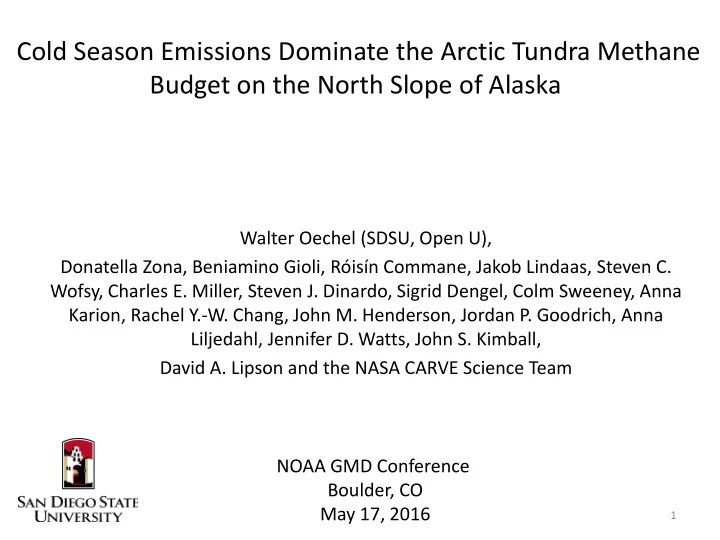

Cold Season Emissions Dominate the Arctic Tundra Methane Budget on the North Slope of Alaska Walter Oechel (SDSU, Open U), Donatella Zona, Beniamino Gioli, Róisín Commane, Jakob Lindaas, Steven C. Wofsy, Charles E. Miller, Steven J. Dinardo, Sigrid Dengel, Colm Sweeney, Anna Karion, Rachel Y.-W. Chang, John M. Henderson, Jordan P. Goodrich, Anna Liljedahl, Jennifer D. Watts, John S. Kimball, David A. Lipson and the NASA CARVE Science Team NOAA GMD Conference Boulder, CO May 17, 2016 1
Permafrost soil C 3 Hugelius et al. Biogeosciences 2014
Objectives Refine rates, patterns, and controls on trace gas fluxes in the Arctic • Better define the seasonal pattern on trace gas fluxes in the • Arctic Better define the spatial heterogeneity of fluxes in the Arctic • Better predict future greenhouse gas feedbacks • Integrate observations, experiments, and modeling • 4
Primary towers in Barrow 5
CO 2 and CH 4 fluxes in the Arctic, Alaska Different approaches Remote sensing Terrestrial Carbon Flux (TCF) model Decades Eddy-covariance towers GMD Barrow Years Following From: Watts, Kimball, Zona, Oechel, et al. 2014 Biogeosciences Seasons Chambers Aircraft Days 6 Plot scale : 1 Ecosystem scale : 10 3 Regional scale : 10 6
Annual CH 4 fluxes North Slope Alaska 2013-2014 7 Zona et al. PNAS 2016
2013 Inundation from AMSR-E Inundation: Blue >10% Lt. Blue 2-5% Grey 1-2% White <1% Contour Intervals 5% Du, Kimball, et al. 2014 Watt et al. 2012
2013 Inundation for study regions from AMSR-E Zona et al. PNAS 2016 Du, Kimball, et al. 2014 9 Watt et al. 2012
Barrow BES Half hour data + daily average flux • No consistent diurnal pattern • Unfrozen “zero curtain” soil layer linked to large fall CH 4 emissions Zona et al., PNAS 2016
Ivotuk
Soil Temperature Distributions Relative Frequency Number of Days
CO 2 , CH 4 , Radon, Diffusivity and Flux System 13
NASA CARVE Aircraft Concentrations and Remote Sensi ng NASA CARVE C-23 Sherpa aircraft 14
NASA CARVE Aircraft CH 4 Concentrations Barrow Atqasuk 2025 ppb 15
Footprint WRF STILT (Stochastic Time- Inverted Lagrangian Transport) Modeling September 6, 2014 November 7, 2014 16 Zona et al. PNAS 2016
North Slope Alaska Fluxes Aircraft vs. Tower Zona et al., PNAS 2016
Terrestrial Carbon Flux (TCF) model simulations of daily methane (CH 4 ) using SMAP, MODIS, MERRA Climate data Watts et al. in prep. Methods: Watts et al. 2013.
Conclusions The cold period is a critical contributor to annual CH 4 fluxes in the Arctic. Based on rates presented here, annual Arctic CH 4 emissions are ~27 Tg which ~50% occur in the cold season. Past models and atmospheric inversions have often been in error by assuming near zero CH 4 fluxes the cold period. Fall “zero curtain” CH 4 fluxes can be substantial compared to summer fluxes Methanogenesis continues in the saturated unfrozen layer. Methanotropy, on the other hand, is suppressed by fall freezing. The relative impact of zero curtain emissions on annual fluxes is greatest in dry sites where methanotropy is highest in the summer. So, drier sites may be significant methane emitters. Extension of the zero curtain under future climate conditions could have significant impacts on annual emissions. Long-term measurements and high resolution models can set the baseline 19 against which change in CH 4 fluxes can be detected.
Thanks to the GCRG SDSU team, collaborators, and funders GMD “Supporting the CMDL tower since 1997”
NOAA EPP SDSU Interns • SDSU is a Hispanic serving institution. • We submitted to the NOAA EPP (NOAA Education Partnership Program)/MSI with the NOAA- Cooperative remote Sensing Science and Technology Center (NOAA-CREST) • If successful, the goal is is to engage more students into stem disciplines including URM. 21
Midnight over the Arctic Ocean Thank you Questions? 22
23
North Slope Alaska Fluxes Aircraft vs. Tower Zona et al., in Review
Footprint WRF STILT (Stochastic Time- Inverted Lagrangian Transport) Modeling CH 4 release: 0.3 mgC m -2 h -1 Zona et al., PNAS 2016
Conclusions The cold period is a critical contributor to annual CH 4 fluxes in the Arctic. Based on rates presented here, annual Arctic CH 4 emissions are ~27 Tg which 11 Tg occur in the cold season. Models and atmospheric inversions have often been in error by assuming near zero CH 4 fluxes the cold period. Fall “zero curtain” CH 4 fluxes can be substantial compared to summer fluxes Methanogenesis continues in the saturated unfrozen layer. Methanotropy, on the other hand, is suppressed by fall freezing. The relative impact of zero curtain emissions on annual fluxes is greatest in dry sites where methanotropy is highest in the summer. So, drier sites may be significant methane emitters. Extension of the zero curtain under future climate conditions could have significant impacts on annual emissions. Long-term measurements and high resolution models can set the baseline 26 against which change in CH 4 fluxes can be detected.
NASA CARVE Aircraft Concentrations and Remote Sensi ng NASA CARVE C-23 Sherpa aircraft 27
Soil Temperature Distributions
Annual CH 4 fluxes North Slope Alaska 2013-2014 Barrow BES Barrow BEO Barrow CMDL Atqasuk- ATQ Ivotuk-IVO 29 Zona et al., PNAS 2016
CH 4 Emissions vs Active Layer Temperature Barrow BES Barrow BEO Barrow CMDL Atqasuk- ATQ Ivotuk-IVO Active Layer Temperature °C (-20 cm or -30cm) Zona et al., in prep. 30
CH4 Flux vs Soil Temp mg C-CH 4 m -2 h -1 Barrow BES Ivotuk
CARVE Aircraft CH 4 Concentrations Barrow Atqasuk 2025 ppb 32
33
Recommend
More recommend